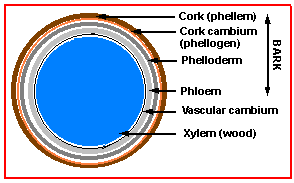|
|
|
|
|
WOODY PLANTS |
|
Woody stems and roots The woody habit has been independently acquired in various divisions of the plant kingdom in the past. Today only the three divisions of gymnosperms and the anthophyta are truly woody. Because of their scattered, closed vascular bundles monocots cannot form wood. In dicots a small apical meristem can give rise to a massive tree because the bundles retain active cambium which can expand the diameter of the stem. Tree-like monocots such as palms have a massive apical meristem that generates the full width of the stem immediately |
|
|
|
|
|
The vascular cambium derives from the procambium which in the stems of dicots persists between the phloem and xylem of the bundles and as interfascicular cambium. In the root the cambium arises partly in the pericycle and partly in the arches between xylem and phloem. There are two kinds of meristematic cell in the vascular cambium: |
|
|
|
|
|
|
|
The ray parenchyma contributes to the characteristic grain of woods; it is more extensive in angiosperms than in gymnosperms and provides an important site of storage of food reserves from year to year. In temperate zone trees the cambium becomes dormant in the fall and activates each spring. This leads to annual rings and the vessels produced in the spring are often larger than in the fall; the large vessels allow for rapid sap movement in the spring, whereas the narrow vessels minimize the risk of cavitation under dry conditions in late summer. This leads to a ring-porous pattern in the wood as opposed to the diffuse porous pattern where vessels are more even in size. As trees age the vessels in the center of the stem become air-filled and cease to carry water; they still function for support and storage of waste products, some of which are colored; this is the heartwood in contrast to the sapwood which carries water and is confined to the outer few annual rings. |
|
|
When a leaf or branch arises from the continuous ring of vascular tissue, xylem and phloem elements curve away from the main stem. They leave a gap above the point of attachment which is closed by adjacent vascular elements. Because of this branches are not as firmly attached on their top side as they are below. This can lead to problems for particular trees under mechanical stress such as snow load. |
|
|
|
|
|
The growth of wood crushes the pith in the center of the stem and soon leads to splitting of the epidermis of both stem and root. A second cambium arises in the cortex of the stem and the pericycle of the root. This is the cork cambium or phellogen. On the outside the cork cambium generates cork cells, parenchyma with cell walls impregnated with suberin (a cross between cuticle and lignin). On the inside the cork cambium generates parenchyma cells that replace the cortex (phelloderm).  |
|
|
|
|
|
In places the cork cambium generates loose and disorganized cells so that the outer cork has pores (lenticels) that allow for oxygen uptake by the stem. In some trees the cork cambium forms a more or less continuous ring, leading to a smooth bark. When there are breaks in the cambium the bark will be fissured or scaly. In contrast to the vascular cambium the cork cambium can be renewed. Sometimes it persists for many years as in the cork oak, Quercus suber so that thick layers of bark are built up. In other trees it functions for a year or so and a new cambium arises on the inside; this leads to a flaky or peeling bark. Gymnosperm wood has the same general structure as dicot wood, but it lacks vessel elements and the rays are less prominent. Resin canals are often a prominent feature. |
|
|
|
|
|
Copyright © Michael Knee, The Ohio State
University |
|